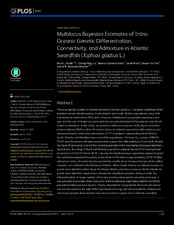| dc.creator | Smith, Brad L. | |
| dc.creator | Lu, Ching-Ping | |
| dc.creator | García-Cortés, Blanca | |
| dc.creator | Viñas, Jordi | |
| dc.creator | Yeh, Shean-Ya | |
| dc.creator | Bremer, Jaime R. Alvarado | |
| dc.date.accessioned | 2015-08-10T19:13:52Z | |
| dc.date.available | 2015-08-10T19:13:52Z | |
| dc.date.issued | 2015-06-09 | |
| dc.identifier.citation | Smith BL, Lu C-P, García-Cortés B, Viñas J, Yeh S-Y, Alvarado Bremer JR (2015) Multilocus Bayesian Estimates of Intra-Oceanic Genetic Differentiation, Connectivity, and Admixture in Atlantic Swordfish (Xiphias gladius L.). PLoS ONE 10(6): e0127979. doi:10.1371/journal.pone.0127979 | en |
| dc.identifier.uri | https://hdl.handle.net/1969.1/154764 | |
| dc.description.abstract | Previous genetic studies of Atlantic swordfish (Xiphias gladius L.) revealed significant differentiation among Mediterranean, North Atlantic and South Atlantic populations using both mitochondrial and nuclear DNA data. However, limitations in geographic sampling coverage, and the use of single loci, precluded an accurate placement of boundaries and of estimates of admixture. In this study, we present multilocus analyses of 26 single nucleotide polymorphisms (SNPs) within 10 nuclear genes to estimate population differentiation and admixture based on the characterization of 774 individuals representing North Atlantic, South Atlantic, and Mediterranean swordfish populations. Pairwise FST values, AMOVA, PCoA, and Bayesian individual assignments support the differentiation of swordfish inhabiting these three basins, but not the current placement of the boundaries that separate them. Specifically, the range of the South Atlantic population extends beyond 5°N management boundary to 20°N-25°N from 45°W. Likewise the Mediterranean population extends beyond the current management boundary at the Strait of Gibraltar to approximately 10°W. Further, admixture zones, characterized by asymmetric contributions of adjacent populations within samples, are confined to the Northeast Atlantic. While South Atlantic and Mediterranean migrants were identified within these Northeast Atlantic admixture zones no North Atlantic migrants were identified respectively in these two neighboring basins. Owing to both, the characterization of larger number of loci and a more ample spatial sampling coverage, it was possible to provide a finer resolution of the boundaries separating Atlantic swordfish populations than previous studies. Finally, the patterns of population structure and admixture are discussed in the light of the reproductive biology, the known patterns of dispersal, and oceanographic features that may act as barriers to gene flow to Atlantic swordfish. | en |
| dc.description.sponsorship | The open access fee for this work was funded through the Texas A&M University Open Access to Knowledge (OAK) Fund. | en |
| dc.language.iso | en_US | |
| dc.publisher | PLOS | |
| dc.rights | Attribution 3.0 United States | en |
| dc.rights.uri | http://creativecommons.org/licenses/by/3.0/us/ | |
| dc.subject | Genetic Loci | en |
| dc.subject | Population genetics | en |
| dc.subject | Gene flow | en |
| dc.subject | Mitochondrial DNA | en |
| dc.subject | Fishes | en |
| dc.subject | Tuna | en |
| dc.subject | Bayes theorem | en |
| dc.subject | Oceanography | en |
| dc.title | Multilocus Bayesian Estimates of Intra-Oceanic Genetic Differentiation, Connectivity, and Admixture in Atlantic Swordfish (Xiphias gladius L.) | en |
| dc.type | Article | en |
| local.department | Other | en |



